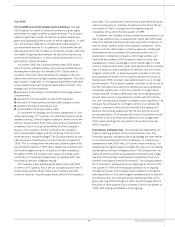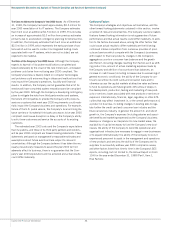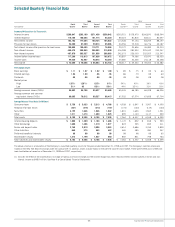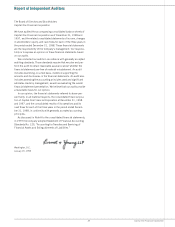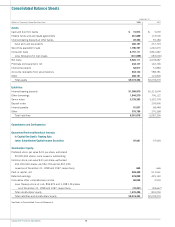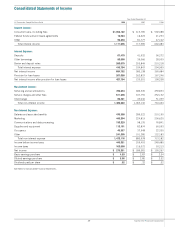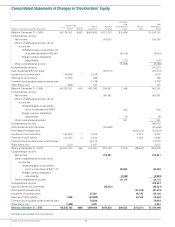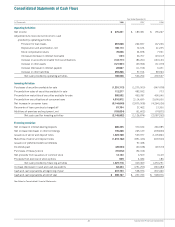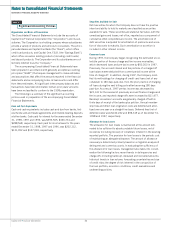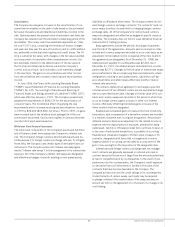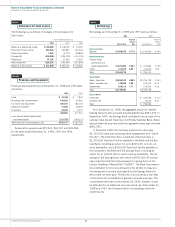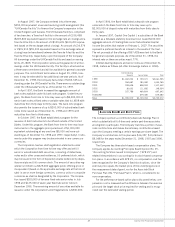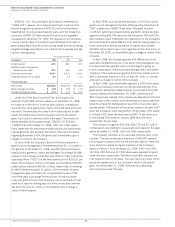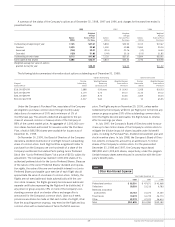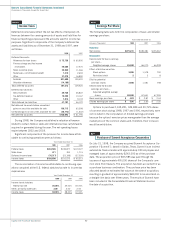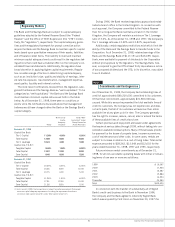Capital One 1998 Annual Report Download - page 44
Download and view the complete annual report
Please find page 44 of the 1998 Capital One annual report below. You can navigate through the pages in the report by either clicking on the pages listed below, or by using the keyword search tool below to find specific information within the annual report.
42Capital One Financial Corporation
Notes to Consolidated Financial Statements
(Currencies in Thousands, Except Per Share Data)
Securities Available for Sale
Debt securities for which the Company does not have the positive
intent and ability to hold to maturity are classified as securities
available for sale. These securities are stated at fair value, with the
unrealized gains and losses, net of tax, reported as a component of
cumulative other comprehensive income. The amortized cost of
debt securities is adjusted for amortization of premiums and accre-
tion of discounts to maturity. Such amortization or accretion is
included in other interest income.
Consumer Loans
During 1997, the Company began recognizing the estimated uncol-
lectible portion of finance charge and fee income receivables,
which decreased loans and pre-tax income by $50,200 in 1997.
Previously, the accrued interest and fee portions of a charged off
loan balance were deducted from current period income at the
time of charge-off. In addition, during 1997, the Company modi-
fied its methodology for charging off credit card loans (net of any
collateral) to 180 days past-due, from the prior practice of charging
off loans during the next billing cycle after becoming 180 days
past-due. As a result, 1997 pre-tax income was decreased by
$23,141 for the reversal of previously accrued finance charges and
fee income, and reported charge-offs were increased by $11,477.
Bankrupt consumers’ accounts are generally charged off within
thirty days of receipt of the bankruptcy petition. Annual member-
ship fees and direct loan origination costs are deferred and amor-
tized over one year on a straight-line basis. Deferred fees (net of
deferred costs) were $140,242 and $98,619 as of December 31,
1998 and 1997, respectively.
Allowance for Loan Losses
The allowance for loan losses is maintained at the amount esti-
mated to be sufficient to absorb probable future losses, net of
recoveries (including recovery of collateral), inherent in the existing
reported portfolio. The provision for loan losses is the periodic cost
of maintaining an adequate allowance. The amount of allowance
necessary is determined primarily based on a migration analysis of
delinquent and current accounts. In evaluating the sufficiency of
the allowance for loan losses, management also takes into consid-
eration the following factors: recent trends in delinquencies and
charge-offs including bankrupt, deceased and recovered amounts;
historical trends in loan volume; forecasting uncertainties and size
of credit risks; the degree of risk inherent in the composition of
the loan portfolio; economic conditions; credit evaluations and
underwriting policies.
Note A
Significant Accounting Policies
Organization and Basis of Presentation
The Consolidated Financial Statements include the accounts of
Capital One Financial Corporation (the “Corporation”) and its sub-
sidiaries. The Corporation is a holding company whose subsidiaries
provide a variety of products and services to consumers. The princi-
pal subsidiaries are Capital One Bank (the “Bank”), which offers
credit card products, and Capital One, F.S.B. (the “Savings Bank”),
which offers consumer lending products (including credit cards)
and deposit products. The Corporation and its subsidiaries are col-
lectively referred to as the “Company.”
The accompanying Consolidated Financial Statements have
been prepared in accordance with generally accepted accounting
principles (“GAAP”) that require management to make estimates
and assumptions that affect the amounts reported in the financial
statements and accompanying notes. Actual results could differ
from these estimates. All significant intercompany balances and
transactions have been eliminated. Certain prior years’ amounts
have been reclassified to conform to the 1998 presentation.
The following is a summary of the significant accounting
policies used in preparation of the accompanying Consolidated
Financial Statements.
Cash and Cash Equivalents
Cash and cash equivalents includes cash and due from banks, fed-
eral funds sold and resale agreements and interest-bearing deposits
at other banks. Cash paid for interest for the years ended December
31, 1998, 1997 and 1996, was $393,565, $346,761 and
$288,568, respectively. Cash paid for income taxes for the years
ended December 31, 1998, 1997 and 1996, was $202,112,
$131,052 and $107,065, respectively.
Notes to Consolidated Financial Statements
(Currencies in Thousands, Except Per Share Data)



